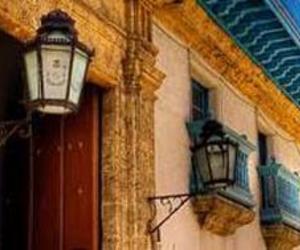Don’t skip Havana on your visit to Cuba
- Submitted by: manso
- Travel and Tourism
- 12 / 01 / 2010

Much of Cuba's architecture, as this pillared and columned passage, recalls its heritage of Spanish design and exquisite artistic sensibility.
I’ve been grateful over the years, that so many fellow Canadians go to Cuba for a week or so during our winter — about 600,000 by most estimates.
But along with my pleasure, there’s a slight regret: not enough of us take time to leave the sunny beaches for a visit to Havana. It’s not just that the city was so central to the historic events of the Castro revolution of the 1950s.
It’s that Havana — population of just over two million — is the repository of Cuba’s profound cultural past of grand baroque form and architecture. It’s an oasis for the eye, one you see in old mansions that slumber in evening shadows of noble boulevards and in stately public buildings rising in what Cuba’s people still call Habana Vieja, or Old Havana.
The finest view of Old Havana’s beauty is from the rooftop of a hotel where I stayed, the Parque Central, managed by Dutch hoteliers, and on the edge of Old Havana.
The scene from its high airy café, is as sweeping as it’s striking: baroque buildings with pillared walkways beneath, grand towers, ornate museums, crumbling old churches, and in the distance, the sun washed dome of Cuba’s old seat of government, the Capitolio, which reminds you of the capitol building in Washington. Taken together it all recalls what a European writer once said upon seeing it: it made him forget all he’d seen before.
Despite its cracked sidewalks, old Havana is a city for walkers. It’s as compact as it is beautiful and vibrant — just under five square kilometres.
So, one morning, after a light breakfast at Parque Central I started out. About 10 minutes away, beneath the surviving grandeur of overhead balconies and sculpted figures, I came to the country’s most renowned cultural legacy: Museo Nacional de Bellas Artes, The Art Museum.
It occupies two buildings and its collections make it the finest art museum certainly in the country, probably in the region.
One building, Palacio de Bellas Artes, on three floors, houses mostly colonial painting and modern 20th century work, and the second, Centro Asturiano, is given to international art, of which, to me, the most impressive was Italian and Flemish. It all led me to gratitude that the Castro years didn’t dismiss art but preserved it and seriously.
Naturally, when in Havana, you’re made especially aware of the Revolution — even though Santiago de Cuba, rather than Havana was the site of the first events of January, 1959.
But it’s in Havana where the Revolution and its major figures are most visible and present today. Likenesses of the late Che Guevera (Fidels’s closest ally) are on wall after wall and young people — especially visiting young people — wear berets with his likeness. For this reason, it’s sensible to include a visit to the most famous of collections: those of the Mueseo de la Revolution.
It’s steps from the art museum, and its most striking irony, is that it’s set in the prerevolution palace of the notorious dictator of Cuba’s past, Fulgencio Batista, whose name recalls something approaching horror.
The museum, on three stories, in certain ways is a slight disappointment, as if it deliberately set out to be a low-budget exhibit: some walls covered with lacklustre photos of Castro, battle plans and propagandistic messages. No matter how justified the revolution was, a museum still requires a sense of curatorial imagination to provide an engaging exhibit.
One object to look for is in the garden beside it — the boat that in 1959, carried Fidel Castro and colleagues from Mexico to Cuba to strike the first blow of the revolution. “Enduring glory,” a Spanish statement reads, “to the heroes of the new fatherland.”
Cuba’s legacy, diligently preserved, includes not just artifacts of the revolution and serious culture, but the light hearted. The best example of this is in its night life — at music halls and night clubs. I recall, for example, the evening a few years ago, when my wife and I got tickets to Tropicana, a song and dance show said to be perhaps the oldest cabaret in the world. (Many hotels sell tickets, and they aren’t cheap, almost $100 a ticket, though this includes food and drink.)
We went by cab and the evening drive made it worthwhile: to a district called Miramar, passing through dusky streets lined by mansions retaining the glory of long gone riches. The show itself was highly professional and flamboyant, though not as revealing as it was years ago, before a leader of the government banned bare breasted costumes, feeling they conflicted with socialist values.
Perhaps it’s because I was raised beside the sea but whenever I go to an island or a coastal town, I deliberately set aside time to spend by the water. In Havana, you will find as I have, a sea view that may well be unsurpassable.
So, take lots of time to go to Havana’s nearby seawall. It’s called the Malecon. For almost four kilometres, the sea washes the city wall. Its vast ever changing ocean is not just memorable, but moving. Especially when you recall the events of history that have taken place upon it, century after century.
Special to The Hamilton Spectator
Source: www.thespec.com/living/travel/article/280222--don-t-skip-havana-on-your-...
Comments